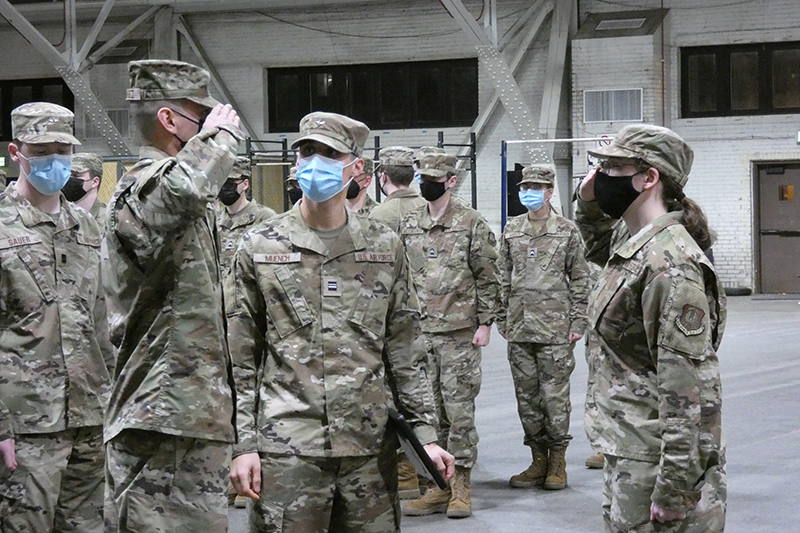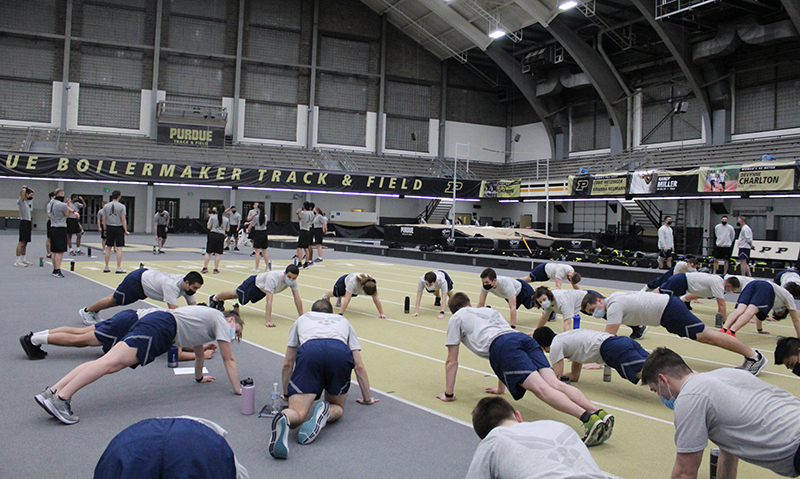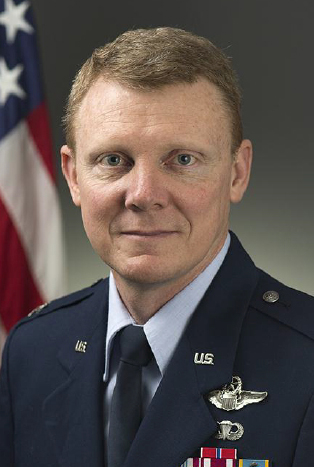March 9, 2022
Purdue Air Force ROTC’s 5-year assessment places storied unit among the best programs in the U.S.

Members of Purdue’s Air Force Reserve Officer Training Corps (ROTC) program participate in their weekly Leadership Laboratory in the Purdue Armory. In these sessions, the upper two classes of Air Force and Space Force cadets instruct freshmen and sophomores on uniform wear, customs and courtesies, drill and ceremony and other activities. (Purdue University photo provided)
Detachment 220 ranked among top 10% nationwide for officers commissioned, those with aviation and technical degrees and program costs per officer
Indianapolis cadet Samantha M. Allen knew Purdue University’s Air Force ROTC unit was among the best in the nation. With the intangible and technical skills gained during her four years in the select program, Allen is confident she’s ready for whatever awaits in today’s ever more challenging and unstable world.
In a just-released viability assessment for the five-year period ended in summer 2021, Purdue’s Air Force Reserve Officer Training Corps (ROTC) program, officially known as Detachment 220, ranks among the top 10% of the 145 U.S. Air Force detachments. The assessment is based on several key factors established by the U.S. Department of the Air Force.
“Air Force ROTC here at Purdue has provided me with more than I could have ever expected,” says Allen, the unit’s 2021 cadet wing commander, who will graduate in May with a bachelor’s degree in applied mathematics and a minor in aerospace studies.
“Through my four years at Purdue, I have gained life and leadership skills that will serve me for the rest of my life — skills in time management, decision making, critical thinking and problem solving. And the cadre we have here has provided me leadership opportunities that I could not find anywhere else,” says Allen, who’s considering Purdue’s engineering graduate program to prepare as an Air Force operations research analyst.
 Air Force and Space Force cadets from Purdue’s Air Force Reserve Officer Training Corps (ROTC) program join together in fitness training at Lambert Fieldhouse, where they meet three times weekly. (Purdue University photo provided)
Air Force and Space Force cadets from Purdue’s Air Force Reserve Officer Training Corps (ROTC) program join together in fitness training at Lambert Fieldhouse, where they meet three times weekly. (Purdue University photo provided)
In evaluating Air Force ROTC detachments nationwide, the military examines five objective factors — the number of officers commissioned each year, those commissioned who are earning a degree in an aviation field, those commissioned who are earning other technical degrees, the average cadet officer qualifying test score and annual costs per officer.
“This is less of an honor for us as it is for Purdue,” says Air Force Col. Ken Callahan, commander of the Purdue ROTC unit. “The U.S. Air Force is saying to Purdue, ‘You’re in the top 10% of the 145 detachments across the country. That of all the schools we work, you are among the best in meeting the needs of the Air Force and the U.S. military.’”
As Detachment 220, Purdue’s Air Force ROTC unit has commissioned an average 24.8 officers per year — compared with a goal of 10 — and rated in the 90th percentile for the five-year assessment period of 2017-21.
Those Air Force officers graduating from Purdue have included, by annual average, 13 with technical degrees and 10.6 in aviation, ranking in the 94th and 92nd percentiles, respectively. Goals for all Air Force detachments in those two categories are six and four, respectively.
The average cost per officer at Purdue, meanwhile, was $43,978, ranking in the 93rd percentile and comparing with a maximum of $78,335 per-officer cost allowed by the Air Force for its detachments. Purdue’s cadet Air Force Officer Qualifying Test (AFOQT) score averaged 67, vs. a target of 55, placing it in the top 84th percentile.
Aligning with Air Force’s mission
With its storied tradition as the “Cradle of Astronauts,” Purdue also lays claim to a top-rated engineering school, renowned science and technology programs and top-tier research as a leading land-grant university. The Purdue University Airport, the first university-owned airport in the U.S., attracts top aviation students and is a key asset supporting the Air Force’s needs. And Callahan says Purdue’s persistent commitment to keep tuition frozen for a decade running is a major factor for in-state and out-of-state students — and the Air Force’s criteria on cost per officer at its detachments.
 Col. Ken Callahan
Col. Ken Callahan
“This assessment is clearly a reflection of the university’s commitment and a natural alignment with the goals and needs of the Air Force,” says Callahan, also a professor of aviation studies who received in doctorate in history from Purdue. “Our aeronautical and astronautical engineering program is one of the best in the country. The College of Engineering is highly rated. We have very strong computer and data science, cyberwarfare and cybersecurity and other STEM-focused programs like meteorology. That is what the Air Force and Space Force look for.”
In past years, the detachment has been recognized as one of the nation’s top four Air Force ROTC programs and has received the Air Force Organizational Excellence and the High Flight awards as the best large detachment in the region.
As the nation’s 10th-largest Air Force detachment, Purdue enrolled 213 Air Force and Space Force cadets this school year. Here, the students not only learn the principles of leadership in the classroom but put them into practice through hands-on management experience, valuable leadership-building exercises and instruction to prepare for a seamless transition as soldiers and officers.
“If you just take the current events of watching what Russia is doing, they started their offensive into Ukraine with a cyberattack,” Callahan says. “So cyber is important to the Air Force, and we have cadets here who are studying computer science, cyberwarfare and cybersecurity. They are now ready and well-prepared to go on to those jobs in the Air Force.”
‘Special bond’ among the cadets
Nuclear engineering major Brayden Buckley, this year’s cadet wing commander, says Purdue’s Air Force ROTC program has become family, instilling the accountability, discipline and structure needed to focus and balance his time and studies.
“I think it is pretty rare in college to go through a lot of the same experiences and spend so much time each semester with so many of the same peers. It has created a very special bond between all of us,” he says. “At times, it is hard to get up at 4:30-5 in the morning, but when you are doing it with 40 other cadets in your class and 200 cadets in the detachment that are all relying on you, it makes it a lot easier and worth it.”
From Gettysburg, Pennsylvania, Buckley credits Purdue’s efforts to keep tuition flat as a key factor to study here. After graduating in May, he plans to pursue a master’s degree in nuclear engineering at the Air Force Institute of Technology.
In September, Gen. David D. “DT” Thompson, U.S. Space Force vice chief of space operations, joined Purdue President Mitch Daniels to announce a partnership between Purdue and the U.S. Space Force to use university research, innovation and talent development as the latest member of the Space Force’s University Partnership Program. Thompson, who received his master’s degree in aeronautics and astronautics from Purdue in 1989, said the partnership leverages the internationally renowned research and educational opportunities available at Purdue to take on the engineering, science and technology issues facing the Space Force.
Cadet Alex Terry was honored to be part of Purdue’s leadership in standing up the nation’s first Space Force Training Squadron— at 40 cadets, it now is the most in the U.S. From his opportunities to refuel a B-2 aircraft mid-flight and receive a scholarship for a private pilot certificate to interning at the Air Force Research Laboratory Space Vehicles Directorate, Terry is excited to commission into the U.S. Space Force as a space operation officer. In that role, Terry, a native of Bedford, Indiana, will oversee space domain surveillance, space vehicle lift, space missile warning, and satellite command and control.
“Detachment 220 has kick-started Space Force ROTC for the rest of the nation to follow. Our cadre has been instrumental in achieving the Space Squadron along with providing professional and educational development opportunities for our cadets,” says Terry, who will graduate in May with a bachelor’s degree in aeronautical engineering technology. “If you want the most opportunities to become the best leader and person you can be, you need to come to Purdue and enroll in the Space Force ROTC program. Purdue will soon be known as the ‘Cradle of Guardians.’”
About Purdue Air Force ROTC
Purdue University’s Reserve Officer Training Corps (ROTC) was established in the fall of 1949, but its roots began with a branch of the Army ROTC program known as the Air ROTC formed in 1946. The first graduates of Purdue Air ROTC were commissioned into the U.S. Air Force in February 1948 as second lieutenants. Over the years, Purdue Air Force ROTC has produced officers that have gone on to become senior Air Force officers, astronauts, and successful leaders in and outside the military.
About U.S. Air Force ROTC
Offered at over 1,100 colleges and universities at 145 detachments across the country, the U.S. Air Force ROTC is the largest and oldest source of commissioned officers, designed to recruit, educate and commission officer candidates through academic education, field training and professional development training programs based on Air Force requirements. Students can attend classes through host or cross-town enrollment programs or consortium agreements. The first Air Force units were established from 1920 to 1923 at the University of California at Berkeley, Georgia Institute of Technology, the University of Illinois, the University of Washington, Massachusetts Institute of Technology and Texas Agricultural and Mechanical College.

